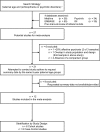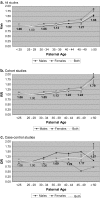Meta-analysis of paternal age and schizophrenia risk in male versus female offspring
- PMID: 20185538
- PMCID: PMC3160220
- DOI: 10.1093/schbul/sbq011
Meta-analysis of paternal age and schizophrenia risk in male versus female offspring
Abstract
Introduction: Advanced paternal age (APA) is a reported risk factor for schizophrenia in the offspring. We performed a meta-analysis of this association, considering the effect of gender and study design.
Methods: We identified articles by searching Pub Med, PsychInfo, ISI, and EMBASE, and the reference lists of identified studies. Previously unpublished data from the Northern Finland 1966 Birth Cohort (NFBC 1966) study were also included.
Results: There were 6 cohort studies and 6 case-control studies that met the inclusion criteria. In both study designs, there was a significant increase in risk of schizophrenia in the offspring of older fathers (≥30) compared to a reference paternal age of 25-29, with no gender differences. The relative risk (RR) in the oldest fathers (≥50) was 1.66 [95% confidence interval (95% CI): 1.46-1.89, P < 0.01]. A significant increase in risk was also found for younger fathers (<25) in males (RR = 1.08, 95% CI: 1.02-1.14, P = 0.01) but not females (RR = 1.04, 95% CI: 0.97-1.14, P = 0.28). The population attributable risk percentage (PAR%) was 10% for paternal age ≥30 and 5% for paternal age <25.
Discussion: Both APA (≥30) and younger paternal age (<25) increase the risk of schizophrenia; younger paternal age may be associated with an increased risk in males but not females. This risk factor increases the risk of schizophrenia as much as any single candidate gene of risk. The mechanism of these associations is not known and may differ for older and younger fathers.
Figures


References
-
- Malaspina D, Reichenberg A, Weiser M, et al. Paternal age and intelligence: implications for age-related genomic changes in male germ cells. Psychiatr Genet. 2005;15:117–125. - PubMed
Publication types
MeSH terms
LinkOut - more resources
Full Text Sources
Medical
Miscellaneous

